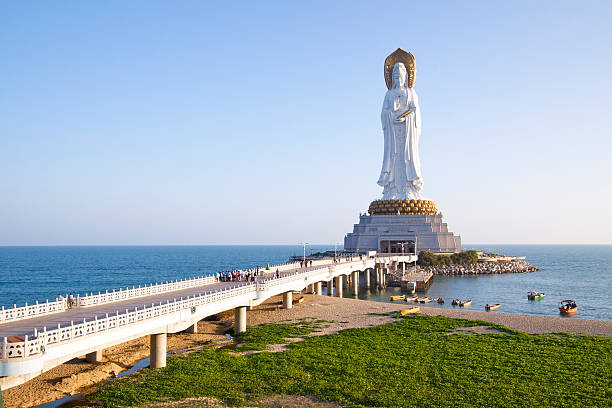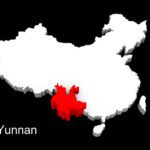Families are the basic unit of society, and their well-being is essential for the overall development of a community or a nation. This technical report provides an overview of family life in the Chinese province of Hainan. This report is written for stakeholders with an interest in family life in China, specifically in the province of Hainan.
The report’s main objective is to provide a concise overview of the conditional state of families using Hainan family demographic statistics (e.g., number of families, family structure, racial and ethnic diversity, marriage rates, divorce rates, family income, etc.).
Data for this report was obtained using open-sourced information, such as the National Bureau of Statistics of China. This methodological approach makes certain that the report’s findings are transparent and replicable, and stakeholders can access, verify, and utilize the data sources themselves.
Overview of Hainan
Hainan province is located in the South China Sea, off the southern coast of mainland China. Dubbed the “Hawaii of China,” Hainan, which means “south of the sea,” consists of various islands, including the largest and most populous, Hainan Island. Hainan is the southernmost province of China and is also the smallest in terms of land area. For centuries, Hainan was part of Guangdong Province, but in 1988, this resource-rich tropical region became a separate province. The capital is Haikou, on Hainan Island’s northern coast. Hainan has a total area (excluding disputed island areas) of 13,200 square miles (34,300 square km).
Hainan’s climate is tropical and monsoonal (i.e., wet-dry). Temperatures average about 64 °F (18 °C) in January and 82 °F (28 °C) in July. Rainfall is heavy, especially in the summer during the wet monsoon. The average annual precipitation varies from about 70 inches (1,800 mm) in the east to less than 60 inches (1,500 mm) in the western coastal area. Tropical storms and typhoons (tropical cyclones) often hit the province, especially in late summer and early fall.
Hainan was one of the world’s few places to be declared a World Longevity Island by the International Expert Committee on Population Aging and Longevity. More than 1,500 centenarians were living in Hainan, with more than 280,000 residents older than 80.
Towering 108 meters (354 feet) above its base, the Buddhist Guanyin of Nanshan, on the southern coast of Hainan, is the world’s tallest Guanyin statue. It is about four times the height of Hong Kong’s Big Buddha and 15 meters taller than New York’s Statue of Liberty. The statue, situated next to Nanshan Temple in Sanya, which took six years to build and opened to the public in 2005, is adorned with gold, diamonds, and other gemstones.
Population of Hainan
According to the Hainan Population Census Yearbook 2022, the population of Hainan is approximately 10.2 million people. People between the ages of 15 and 64 account for 69.61% of the population. Haikou, Sanya, and Danzhou are the cities with the largest residential population. Specifically, approximately 2.9 million people live in Haikou, the capital city of Hainan, and 2.4 million of those residents live in urban areas of Haikou.
Hainan’s ethnic minority groups make up more than 15% of the total population. The two largest minority ethnic groups are the Li (243,780) and the Hui (11,526). The Han still account for the majority of the population in Hainan, which is 84.3%. From 2013 to 2023, the proportion of ethnic minorities in the total population decreased from 16.44% to 15.70%.
Ethnic Group
Hainan Island is home to a diverse population, including the Han, Li, Miao, and Dan ethnic minorities, and expatriates from all over the world. One of the most captivating features of Hainan is the presence of its indigenous ethnic communities, who have resided on the island for millennia with minimal external influence. Their rich culture, traditions, and lifestyle have been well preserved, especially in the remote mountainous regions at the island’s core.
The Li
The Li make up more than 13.44% of the total population and possess a unique and rich culture with their own set of customs as the most prominent among the ethnic minority groups residing on Hainan Island. Additionally, they communicate through their native language, Hlai, which exhibits linguistic connections to languages spoken in various regions of Southeast Asia, including Thai and Lao. They currently have a population of about 1.14 million. The Li communities can be found across the southern half of Hainan Island, occupying both the mountainous terrain and the lowland areas. These Li communities are organized into five distinct branches, namely, Ha, Qi, Run, Sai, and Meifu, with each branch distinguished by its specific geographical location as well as differences in language and traditional attire. Li women are renowned for their exceptional weaving abilities, and they are credited with pioneering some of the earliest weaving techniques in China.
The Hui
Though labeled as Hui because of their adherence to the Muslim faith, these individuals are more accurately identified as Utsuls (Muslim Chams), believed to have originated from the ancient Champa kingdom in what is present-day central Vietnam. They were allowed to settle in Hainan after being displaced from Champa due to the southward expansion of the Vietnamese state in the 1470s. Their unique language has roots in Malay and Polynesian languages, but over time, it has evolved to adopt tonality, perhaps as a result of exposure to Chinese. While once more widely dispersed across the island, the Hainan Hui population is now concentrated primarily around Phoenix Town, near Sanya’s airport, totaling around 8,300 individuals. The Hainan Hui follow Sunni Islam and uphold Islamic traditions like Ramadan and the Eid festival (Hari Raya Puasa).
The Miao
The Miao ethnic community is scattered across the southwest regions of China and also resides in Vietnam, Thailand, and Laos, known as the Hmong. Originally dispatched as soldiers from Guangxi during the Ming Dynasty (1368–1644), the population of Hainan Miao presently stands at approximately 60,000. Their separation from the mainland population has led to distinct variations in language, culture, and dress. Concentrated primarily in the mountainous territories surrounding Baoting and Wuzhishan, the Miao uphold unique festivals, customs, and traditional attire distinguished by intricate silver embellishments adorning their headwear and garments.
The Dan
Although not formally acknowledged as a minority group, the Dan possesses an exceptionally unique and captivating culture. Primarily fishermen, these communities are situated along the island’s coastline, unmistakable for being entirely constructed over water. Historically, many Dan individuals spent their entire lives on boats and floating residences without ever stepping foot on land. Spread across Southern China, including a sizable population near Sanya, these communities operate restaurants on their boats and houses in the Sanya region, often transporting customers from the shore.
Culture
Traditional customs and beliefs often revolve around nature, such as the worship of ancestors and spirits related to natural elements. Hainan’s tropical climate and its coastal proximity exert a profound influence on its cultural tapestry. Notably, the Hainan Tropical Rainforest and the Traditional Settlements of the Li Ethnic Group have been nominated for consideration in the UNESCO World Heritage Sites’ Tentative List. Nestled within the central and southern expanses of Hainan Island, this territory serves as a haven for a multitude of endangered and native species. Moreover, it stands as the paramount locale where the Li ethnic community has flourished for centuries, cultivating a symbiotic rapport between mankind and the island’s unique natural surroundings.
The traditional villages of the Li ethnic group within this proposed site hold immense historical and cultural significance. Their tangible cultural heritage, such as village layout and traditional architecture, along with intangible cultural elements like farming practices, customary rituals, dialects, clothing norms, and textile craftsmanship, vividly showcase the cultural identity of the Li ethnic group. The choice of site, arrangement of space, architectural design, and construction techniques seen in the traditional villages of the Li ethnic group exemplify the Li people’s astute reverence for nature and their resourceful utilization of it. These elements not only mirror the principles and communal perspectives of the Li ethnic group’s forebears but also symbolize the harmonious interconnection between humanity and the natural world.
Hainan has long been on the fringe of the Chinese cultural sphere. Traditionally, the island was a place of exile for criminals and disgraced officials.
Family Demographics

Chinese family on a beach stroll, Hainan, China.
Hainan’s family demographics exhibit a notable trend, with a relatively small average household size and a significant proportion of elderly individuals. In 2021, the average family size in Hainan province decreased to 3.18 people, marking a decrease of 0.28 compared to 2010.
Hainan also has a high proportion of elderly people. This trend aligns with Hainan’s reputation for health benefits, verdant landscapes, and long life expectancy, rendering it a prime choice for elderly immigrants. Studies indicate that migrant elders often report better health and reduced levels of depression compared to their local counterparts. Factors like age, education, monthly income, and chronic illnesses could contribute to these differences.
The population aged 60 and over in 2021 accounts for 14,765,599 individuals (14.65%), among which 1,051,500 (10.43%) are aged 65 and over. Comparing these figures to 2010, there has been a notable increase of 3.32% in the population aged 60 and over, with a rise of 2.36 percentage points among those aged 65 and over. Moreover, 17 cities and counties show an elderly population aged 65 and above exceeding 7%, with 3 of them surpassing a 14% proportion.
Marriage rates
In 2022, the number of marriages reported in Hainan stood at 51,441, marking a decline from the preceding count of 60,095 in 2021. This annual data, tracked from December 1999 up to 2022, maintains an average of 65,586 cases. The peak occurred in 2009, reaching an all-time high of 129,952 marriages, while the lowest recorded count dipped to 32,000 marriages in 2002.
In 2021, Hainan recorded 15,348 divorces, a drop from the previous year’s figure of 22,970. The divorce rate peaked at 22,970 cases in 2020 and bottomed out at a historic low of 2,769 cases in 1995.
Family is very important in Hainan culture and has a profound influence on individual behavior and family decision-making. Research investigated how Chinese family culture affects marriage stability, analyzing data from the China Family Panel Studies. Results indicate a clear, positive correlation between family culture and marriage stability. Specifically, this connection is strongest among individuals who place less emphasis on family well-being, those with lower educational attainment, and people residing in smaller families. Moreover, the study highlights that the favorable influence of family culture on marriage stability is particularly evident among older generations, specifically those born before 1969.
Education
Education holds significant importance within family life in Hainan, placing a strong emphasis on academic success. Families frequently prioritize investing in their children’s education, leading to an increasing inclination to send them overseas for higher studies. In 2021, 1,403,194 people had a university (college and above) education, while 1,568,761 had a high school education. Among the population, the number of illiterate people (those aged 15 and above who cannot read or write) was 327,406, marking a decrease of 25,230 compared with the sixth national census in 2010. Since then, the illiteracy rate fell from 4.07% to 3.25%, a decrease of 0.82%.
The Hainan Provincial Education Department and 10 other departments have jointly announced plans to raise the count of approved doctoral and master’s degree programs in Hainan province by around 50 before 2025. Their objective is to improve the allocation of roughly 20% of academic disciplines within the province’s higher education institutions.
Conclusion
In summary, Hainan Province presents an intriguing context for family science research due to its blend of traditional customs and modern influences, as well as its unique demographic and geographical characteristics. Researchers in this field can investigate various aspects of family life and well-being in Hainan to contribute to our understanding of how families adapt to changing socio-cultural and economic contexts.
As a researcher in family science, Hainan offers a number of unique opportunities. The province’s diversity of population and family structures makes it an ideal place to study a wide range of family-related topics. Additionally, Hainan’s rapid social and economic change provides a unique opportunity to examine how families are responding to new challenges and opportunities.





